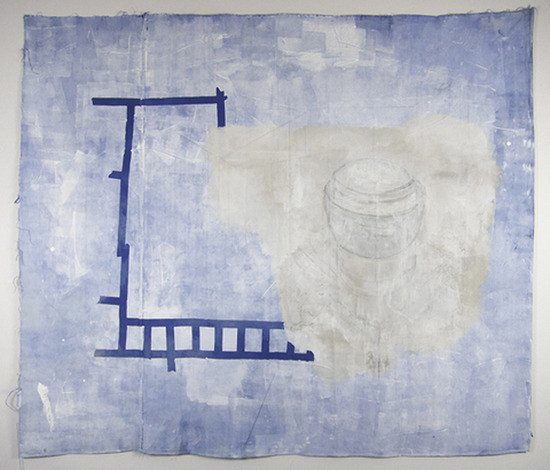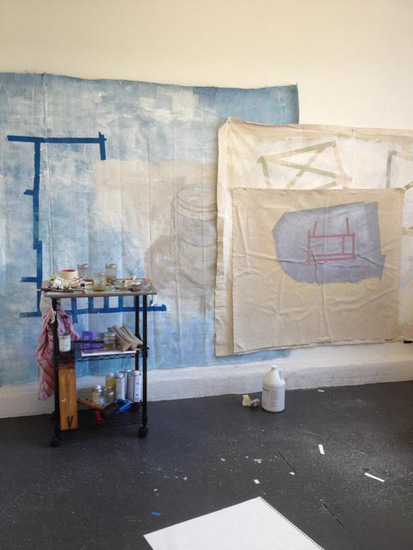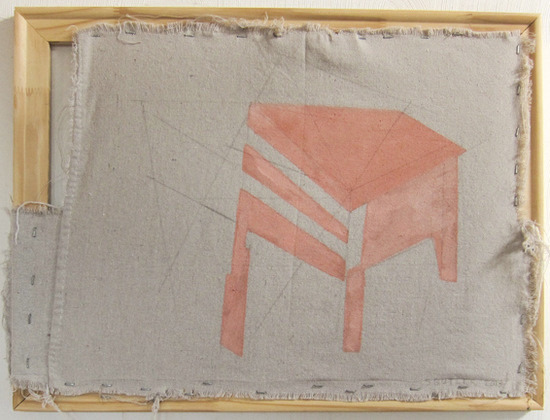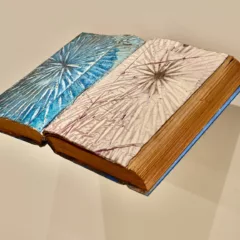(Elizabeth tours Skin, a group show, and speaks with New Casualist painter Sharon Butler about Butler’s approach to failure, success, and “rightness” in her work. — the Artblog editors)
My eye fastens on a crumpled staple in Sharon Butler’s painting, and then I get it. A sense of loosening my expectation of what painting can or should be invades me. Butler and I are in front of “Silencer,” her large painting made with house paint on a linen tarp that has been nonchalantly stapled to the wall. I am stretching canvases this week and have removed many crumpled staples to perfect the process; I can’t ignore this one rogue staple. Front and center, like a chipped tooth, it grins at me, saying, “I barely function, therefore I am.”

We are at Skin, a group show at The Painting Center in Chelsea, and Butler tells me she started “Silencer” as Hurricane Sandy was barreling toward New York. A flat, masked-off-and-painted fragment of an architectural drawing dominates “Silencer,” suggesting a piecemeal, overhead perspective. Water references, including a mottled, blue background and a floating vessel shape, economically layer the sensations of being both “inside” and “in front of”.
We discuss Butler’s attraction to failure. “I know how things should be,” she says, “but at this late date, I’m unwilling to do them the right way, and I live with the consequences.” Multiple, discordant perspectives that don’t add up, the humble droop of canvas, and the painting’s reference to censorship (or a muffled gunshot?) make me feel deflated. “Silencer” seems to miss expressive power by just a hair. Powerlessness, ever linked to failure in America, followed by stubbornness, resignation, and acceptance, are central to Provisional or New Casualist Art; likewise, these emotions dominated the news during Hurricane Sandy.

Defining New Casualism
In a 2011 article in The Brooklyn Rail titled “Abstract Painting: The New Casualists,” Butler denotes “a studied, passive-aggressive incompleteness” that she equates with Raphael Rubinstein’s Provisional Painting and Stephen Maine’s “incipient image”. Her second painting in the show, “Pink Thing,” allows the canvas to fray and exposes stretcher bars, as if to say, “I purposefully stopped before I started,” or “I can do even less.” The idea of stripping back the layers of paint or returning to pre-Renaissance painting interests me, and I begin to think in terms of fractions of effort, small victories, and good or bad luck.

My question for New Casualism is: Is it no longer necessary to separate incompetent artists from the competent who intend to fail? For example, I asked Butler how the wear and tear that happens to paintings over time or in transport affects her work. She answered, “My feeling is that as long as I own the work, it is evolving. If a painting becomes dirty or ripped while in my care, that’s part of the piece. Once someone else buys it, the painting must be maintained in the condition it is received.” So I gather that mistakes, decay, or failure are selectively chosen.
New Casualists seem to circumvent judgment and take control of how contemporary art is judged, yet they distance themselves from actual failure. Addressing judgment in New Casualism, Butler states: “If the viewer leaves a show of paintings agitated by their abrupt shifts, crosscurrents, and purposeful lack of formal cohesion, the work has succeeded.” She tells me that she tries “to avoid making the work look ‘right’…As I work, I don’t think about how it looks too much. Maybe other artists like to work in series with narrowly defined materials, ideas, and approaches, but, after making, say, five pieces that explore a certain vein, I usually move on.”
When we leave the gallery, I say, “I feel like your paintings have to fend for themselves.” She laughs. “We all have to be tough.”

This year, Butler’s blog, Two Coats of Paint, was awarded a Creative Capital grant. She shows at Pocket Utopia in New York, and thrives as she juggles art writing, painting, and teaching. She encourages artists to collaborate, to start their own blogs, curate shows, and open galleries. Courting success while courting failure as a look, style, or approach empowers Ms. Butler. A New Casualist takes a leadership role in the art world, and if rigorous painting is a casualty of this step forward, the implication is: so be it. In fact, “failure painting” is, for the moment, the pirate flag, a signal of unity in a world where we can’t stop hurricanes or return to yesterday’s rules.
Skin was on view at The Painting Center in Chelsea in New York City from November 26, 2013 – December 21, 2013.









